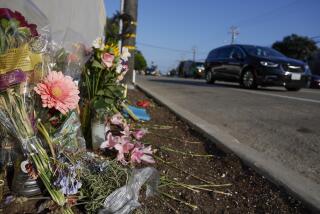A Turn for the Worse?
Improper left turns are the leading cause of injuries and fatalities at Orange Countyâs most dangerous intersections, according to a Times analysis of state accident statistics.
Many of these intersections use a controversial type of traffic signal that allows motorists to make left turns on green lights as long as oncoming traffic is clear. These signals are favored by some city engineers because they result in fewer delays than traditional left-turn signals, which allow turns only when oncoming traffic is stopped.
But the signals can also increase the potential for accidents, some experts say, because motorists often misjudge the speed of oncoming traffic and fail to âshoot the gapâ between cars.
Converting to the traditional left-turn signal costs $10,000 to $20,000 per intersection, and several cities have done so in an effort to improve safety.
The Times review of state traffic data from the last five years found that so-called âprotected-permissiveâ signals are used at eight of the 20 Orange County intersections with the most injury or fatal accidents.
Left-turn accidents caused a disproportionate share of injuries at these intersections, according to the computerized data analysis. Nearly half the total injuries involved a failure to yield before turning, followed by red-light running and speeding and drunk driving.
Traffic engineers debate whether the potential dangers of these signals outweigh the time savings and improved traffic flow they bring to congested intersections.
In Huntington Beach, which is home to eight of the 20 most dangerous intersections, officials are planning to install regular left-turn lights at some intersections after their own research pointed out safety problems.
Irvine recently replaced all of its protected-permissive lights following a two-year study that raised alarms about driver confusion and safety.
âThey did reduce the delays, but the accidents increased,â said Barry Greenstein, Irvineâs senior civil engineer. âThe trade-off was not acceptable to the city.â
But other communities remain supportive of the signals and report no problems. In fact, Tustin, Fountain Valley and Costa Mesa have recently added new protected-permissive signals, saying they are favored by motorists.
âWe receive a number of calls wanting the lights,â said David Sorge, Costa Mesaâs operations engineer. âAnyone traveling through [the intersections] can see obvious benefits.â
The Times compiled a list of the 20 most dangerous intersections using five yearsâ worth of data provided by the California Highway Patrol from local accident reports. The statistics also allowed The Times to pinpoint the causes of the accidents.
The worst intersection identified by the analysis is the northbound offramp of the Santa Ana Freeway at Harbor Boulevard, with 53 injury-producing crashes over the five-year period. Most of the accidents at this intersection as well as other freeway offramps on the list occurred because of motorists running red lights, the survey found. This intersection, however, has been radically redesigned as part of the Santa Ana Freeway widening project.
The analysis did not take into account accidents that occur on freeways and between intersections. A review of all accidents in Orange County found red-light running to be the top cause of injury or fatal accidents, followed by improper left turns, excessive speed and drunk driving.
At the eight intersections on the Times list with protective-permissive signals, improper left-hand turns were the biggest cause of accidents--156 of the 242 crashes. The accidents resulted in dozens of injuries.
The second most dangerous intersection on the list, Huntington Beachâs Warner Avenue-Newland Street junction, was typical. Nearly 80% of the 42 accidents occurred because motorists failed to yield while making left turns.
People who work nearby said theyâre accustomed to hearing the screech of brakes and the crash of metal against metal. Some have even developed routine emergency responses.
âWhen we hear those brakes lock up and the cars colliding, we just follow the noise,â said Mike Bennett, manager of a gasoline station on the corner. Donning orange vests and carrying cones, Bennett and his mechanics often rush to block off the accident scene and begin directing traffic.
He said theyâve assisted several accident victims in the last few years, including a 35-year-old man who was bleeding from a neck injury after his head smashed through a car window. âI had to hold his neck until the paramedics showed up,â Bennett said.
Like many cities, Huntington Beach began installing the signals about 10 years ago, convinced that they would ease increasing congestion. Popular for decades in other parts of the country, the signals didnât catch on in Orange County until relatively recently, and Huntington Beach was among the first to aggressively install the lights.
Distinguished by their five-bulb design, the signals divide turning left into two phases. At the beginning of a traffic cycle, a green arrow lights up and motorists can turn left because oncoming cars are stopped. After the green arrow turns off and a regular green light turns on, motorists can continue to turn left as long as itâs safe to do so, usually between gaps in traffic.
Turning at such intersections requires excellent visibility and adequate timing; as a result not all intersections are suitable for the signals, experts said. Engineers recommend protected-permissive signals be installed only at intersections with relatively small volumes of traffic, low speed limits and good sight lines.
While such signals are used at 40% of the 20 most dangerous intersections, they represent a much smaller percentage of the total signals in Orange County. In Huntington Beach, 29 of its 114 signals are protected-permissive, while 27 of Anaheimâs 271 are.
In some cities, officials express satisfaction with the signals. Driver frustration is declining, they say, because the signals provide more freedom. Gone are the days when drivers turning left had to wait for their light to change, even when there was no traffic.
âMotorists can turn when they feel like it, rather than wait for the arrow,â said Mark Lewis, the traffic engineer in Fountain Valley. âThe public is liking it.â
Proponents say the signals also result in fuel savings and reduced pollution because cars donât idle for minutes at intersections. As long as the public is educated about the signals and engineers place them at appropriate intersections, the benefits outweigh any drawbacks.
But critics maintain that the smoother traffic flow isnât worth the safety risks and that the signals leave too little room for error.
In Westminster and Orange, traffic engineers have resisted modifying any of their traditional signals, fearing an increase in accidents.
âMy chief concern is safety; thatâs why Iâm not using them,â said Hamid Bahadori, Orangeâs traffic engineer. âThe benefits are exaggerated, and I donât think that a few seconds saved here and there really justifies their use.â
The findings of the Times analysis come as no surprise to Bahadori and others. They say the high accident totals point to driversâ lack of understanding about how such signals operate.
Many motorists get confused, they say, when they approach intersections and see a five-bulb signal. Assuming that the solid green light provides a clear turning lane, drivers donât realize that oncoming traffic also has a green signal.
âThe key is driver [education]. Getting people to adhere to a certain operation is a problem, and I donât know that people have fully adapted,â said Dennis Schmitz, the traffic operations engineer for the city of Orange.
Michael McNally, a UC Irvine civil engineering professor, agreed: âThe key rule in traffic engineering is: âDonât do anything that surprises drivers.â Accidents occur when there are surprises, and when you train drivers in Southern California to expect one thing, and then you change it, thatâs a problem.â
The high accident rates at Newland and Warner, as well as other Huntington Beach intersections, have prompted officials to reassess their policies. Even though they once aggressively installed protected-permissive signals, officials are now scaling back.
Two of the seven most dangerous intersections have already been converted to traditional signals, and another is currently being modified, according to the Times analysis. Officials have requested funds to change three other protected-permissive signals.
Tom Brohard, Huntington Beachâs traffic engineer, said he believes the signals work fine at certain intersections. But the cityâs research turned up a disturbing pattern of accidents at some intersections, especially those where drivers have to cross three lanes of traffic when making a left turn.
Like the intersection of Warner Avenue and Springdale Street, No. 4 on the Times list of dangerous intersections. Officials have decided to remove the protected-permissive signals at this intersection. But the move wonât come too soon for some residents.
âThis corner is really like accident corner,â said Susan King, the owner of a nearby flower shop. âYou sit here and every week you hear the screech and the banging noise. Itâs so frequent it scares me to drive down there.â
*
Times staff writer Allison Cohen and correspondent Louise Roug contributed to this report.
(BEGIN TEXT OF INFOBOX / INFOGRAPHIC)
Dangerous Signal?
The protected-permissive left-turn arrow system used by some cities to promote traffic flow is seen as a hazard by some traffic planners.
PROTECTED
Left turn arrow allowed on left arrow only.
PROS:
* Less chance of driver error that can cause an accident.
CONS:
* Driver turning left has to wait through an entire cycle.
* Traffic backs up in left-turn lane.
PROTECTED-PERMISSIVE
Cycle begins with left turn arrow only, same as in fully protected system.
Left turns are allowed on green light after green arrow disappears, but motorist must watch for oncoming traffic.
PROS:
* More control for driver turning left, who doesnât have to wait complete cycle.
* Better traffic flow, fewer backups in left turn lane.
CONS:
* Drivers misjudge speed of oncoming traffic.
* Driver confusion. Some drivers donât realize they can turn without a green arrow.
More to Read
Sign up for Essential California
The most important California stories and recommendations in your inbox every morning.
You may occasionally receive promotional content from the Los Angeles Times.











